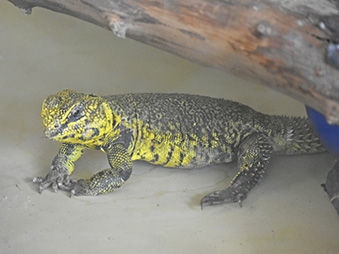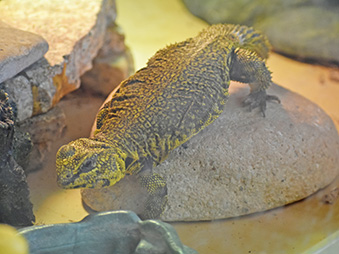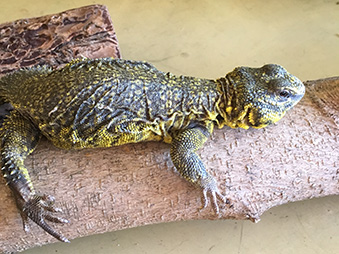Uromastyx geyri | Geyr’s spiney-tailed lizard, Uromastyx
Name: Yoshi



Meet Yoshi the Uromastyx
Say hello to Yoshi, our vibrant Uromastyx geyri—also known as the Uromastyx or Geyr’s spiny-tailed lizard! Native to the arid deserts of north Africa, this hardy herbivore is built to survive in some of the world’s hottest and driest places. With bright, warm-colored scales and a tail full of spikes, Yoshi is as eye-catching as he is resilient.
Life in the Heat
Uromastyx call the scorching sands of countries like Algeria and Niger home, where temperatures soar above 100°F. To beat the heat, Yoshi uses one of his most important survival skills—burrowing. He digs deep tunnels to stay cool during the day and to hide from predators.
Unlike many desert lizards, Uromastyx are strict vegetarians, thriving on a diet of leaves, seeds, flowers, and even cactus pads. At the zoo, Yoshi enjoys a nutritious spread of mixed greens, produce, lentils, Mazuri Tortoise Diet, edible flowers, and his absolute favorite—hibiscus blooms!
Built for Defense
Don’t be fooled by his mellow lifestyle—Yoshi is well-equipped to handle danger. His thick, spiny tail acts like a miniature mace, capable of delivering a sharp smack to would-be predators. This tail is also how the species earned the nickname “spiny-tailed lizard”.
Fact Sheet
Taxonomy
Species: Uromastyx geyri
Kingdom: Animalia | Phylum: Chordata | Class: Reptilia | Order: Squamata | Family: Agamidae | Genus: Uromastyx |
Favorite Enrichment Type
Anything that he can use as a house (the flatter the better) but also things with textures like baby crinkle blankets, a NP strip pile, and toys that wobble when he walks by.
Diet
- In the Wild: Fresh, leafy greens.
- At the Zoo: Mixed greens, mixed produce, lentils, Mazuri® Tortoise Diet, edible flowers, and cactus pad.
Life Span
- In the Wild: Up to 15 years
- In Human Care: Up to 30 years
Geographic Range
Found in northern Africa, specifically Algeria, Mali, and Niger.
Habitat
Arid deserts and semi-arid regions that are rocky, such as inland cliffs and mountain peaks.
Did You Know?
- Uromastyx are ectothermic, meaning they rely on external heat to regulate their body temperature. They spend hours basking to stay warm.
- While Yoshi’s species reaches about 10 to 18 inches, the Egyptian Uromastyx (Uromastyx aegyptia) can grow over 30 inches long!
- These lizards can close their burrows with their tail to block out heat and predators.
- Their urine is paste-like, helping them conserve water in harsh, dry conditions.
Status: Near Threatened
Conservation Matters
While Uromastyx are still found in the wild, they are currently listed as Near Threatened due to habitat loss, climate change, and overcollection for the exotic pet trade. These pressures have caused dramatic declines in some populations, making education and conservation efforts more important than ever.
Yoshi may live behind the scenes, but he still plays an important role as an ambassador animal, helping us teach guests about desert ecology, reptile adaptations, and the importance of protecting wildlife around the globe.
Not a Pet: Why Uromastyx Don’t Belong at Home
With their colorful scales and unique spiky tail, it’s easy to see why Uromastyx like Yoshi might tempt someone looking for an exotic pet—but don’t be fooled. These lizards are not suited for life in a typical household.
Uromastyx geyri come from extremely hot, dry desert regions and have very specific habitat needs, including intense UVB lighting, high temperatures for basking (110°F+), and carefully controlled humidity. Without this specialized care, they can suffer from serious health issues such as metabolic bone disease, dehydration, or organ failure.
Even worse, many Uromastyx in the pet trade are wild caught, which harms native populations and increases their risk of extinction. Removing them from the wild also disrupts fragile desert ecosystems and often results in high mortality rates during capture and transport.
And while they might look low maintenance, they require:
- A large, secure enclosure.
- Frequent cleaning and vet care.
- A strict herbivorous diet.
- Years of commitment—they can live up to 30 years!
Instead of bringing a wild animal home, you can help protect Uromastyx in more sustainable ways:
- Support conservation programs working to protect desert habitats.
- Avoid purchasing wild-caught reptiles or supporting the illegal pet trade.
- Visit AZA-accredited zoos, where animals like Yoshi are cared for by experts and serve as ambassadors for their species.
By appreciating Uromastyx in professional care—not in private homes—we help protect wild populations and promote a better future for desert reptiles everywhere.
How to Find Me
Yoshi is a member of our Ambassador Animals that live behind the scenes! If you would like to meet Yoshi in person, check out our daily, 11:00am Amphitheater Presentations at the Awareness Amphitheater, located just beyond the covered bridge. Amphitheater Presentations are dependent on the weather. Please check our activity board, behind the Admissions booth, before coming to see us!
